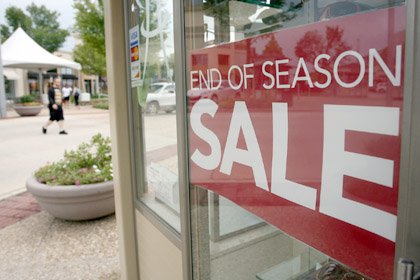LITTLE ROCK — When Wal-Mart Stores Inc. reported second-quarter earnings this month that exceeded expectations, the company's top officer, Mike Duke, also cited a "new normal" of shoppers spending less and saving more, which trimmed sales.
The phenomenon has other names, among them "new frugality" and "new reality," both of which are other ways of saying consumers are likely to continue spending less than before, despite some signs of economic recovery.
In many cases, consumers have no choice. Some of their spending in recent years was driven by credit that is no longer readily available.
Layoffs, furloughs and pay cuts also have shrunk household budgets. The U.S. unemployment rate hit 9.4 percent in July, 7.4 percent in Arkansas.
If there's an upside to the bad news, retailers have trimmed costs, reduced inventories and made other adjustments. The result: as of Thursday, 73 percent of the retailers tracked by research firm Retail Metrics LLC had beat analysts' earnings forecasts in their latest quarterly reports.
"Most of the major retailers have done a phenomenal job of managing through this and cutting costs," said Patricia Edwards, the analyst who heads up Storehouse Partners LLC in Seattle.
At the household level, personal finance specialist William Bailey at the University of Arkansas at Fayetteville sees the reported upturn in personal savings as a long-term plus for the economy, despite some short-term pain. Consumer spending accounts forabout 70 percent of the nation's gross domestic product, the value of all goods and services produced in the nation.
If people are saving more, they are spending less.
In the recent past, Bailey said, many people were taking out second mortgages on their homes to pay off credit-card debt, then running that debt up again. With the collapse of the housing market, some now own homes worth less than they owe on them.
"A frugal perspective is one of the silver linings for this pretty dark cloud," he said. "The key is, people are tightening their belts. In the long run, that's good forfamilies. The question is, how is it affecting the recovery of jobs?"
Edwards also sees a cloud over the otherwise positive earnings reports. Of the companies she tracks, only 18 percent of those reporting higher earnings also had year-over-year revenue growth.
Trimming inventories and corporate overhead are fine, she said, but long term, "you can't cost-cut your way to prosperity."
BIGresearch LLC of Columbus, Ohio, which tracks consumer behavior, found earlier this month that even those in households with $100,000-plus annual incomes are trimming their spending.
Among households with incomes from $100,000 to $150,000, the survey found, 23.1 percent reported buying more store-brand and generic products, up from 15.5 percent two years ago. In the $150,000 to $200,000 income range, the figure jumped from 6.6 percent to 20.1 percent.
Coupon use in the highest-income category more than doubled to 30.8 percent, the survey conducted earlier this month found.
The Conference Board, based in New York, reported Tuesday that its Consumer Confidence index rose to 54.1 this month from 47.4 in July. An index level of 90 is considered the minimum level associated with a healthy economy.
University of Arkansas economist Kathy Deck said the "new normal" for consumers more closely reflects the reality of household incomes.
Borrowing money to pay for college comes with a reasonable expectation for rising income in the future to pay it back, she said.
Consistently spending more than you're earning, when prospects for rising income are not great, is a different story.
"We, in aggregate, were engaging in activity that was not sustainable in the long term," said Deck, director of the Center forBusiness and Economic Research at the University of Arkansas at Fayetteville.
Nowadays, she said, people "justifiably are saving more," and that comes at the expense of consumption.
"That's the paradox of thrift," Deck said.
Consumer advocate Harvey Rosenfield, founder of the California-based group ConsumerWatchdog, puts much of the blame for the current economic situation on credit-card companies that offered easy access to credit, then raised fees, interest rates and, in some cases, minimum payments when the economy soured.
Now, many can't use those cards at a time of when they've lost their jobs and have little money on which to live.
"This is forcing the American consumer to go cold turkey, and it's devastated the economy," he said. While perhaps commendable "in the abstract," he said, "this is not going to be a good thingfor people that make flat-panel TVs."
Janneke Ratcliffe, who oversees research on lending and financial services at the University of North Carolina at Chapel Hill, said the financial scenario that played out over the past several years could not continue. Substantial research showed that consumers were using credit cards and home equity loans to pay for groceries, school expenditures and other day-to-day needs, said Ratcliffe, associate director of the university's Center for Community Capital.
"That doesn't sound sustainable to me," she said.
Consumer spending will turn around only when companies begin hiring again, Ratcliffe said.
"The simplest thing is, if they have jobs, they're going to spend," she said.
That does not bode well for a consumer-driven economic rebound, said Deck, the University of Arkansas economist.
"The new reality is, of course, that we expect unemployment rates to be higher for the next several years," she said.
Business, Pages 69, 70 on 08/30/2009
